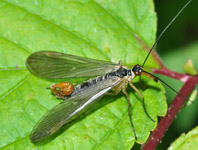Abstract
Two spongillaflies species are described and illustrated from Eocene Baltic amber: Paleosisyra minor n. sp. and Paleosisyra electrobaltica Wichard et al., 2009; the latter species was described based on a female and is now re-described in consideration of the male genitalia of two new male specimens. Extant Sisyridae comprise few species, and their fossil record is very scarce.
References
Aspöck, U. & Aspöck, H. (2008) Phylogenetic relevance of the genital sclerites of Neuropterida (Insecta: Holometabola). Systematic Entomology, 33, 97–127.
http://dx.doi.org/10.1111/j.1365-3113.2007.00396.xBanks, N. (1905) A revision of the Nearctic Hemerobiidae. Transactions of the American Entomological Society, 32, 21–51.
Banks, N. (1913) Synopses and descriptions of exotic Neuroptera. Transactions of the American Entomological Society, 39, 201–242.
Banks, N. (1939) New genera and species of neuropteroid insects. Bulletin of the Museum of Comparative Zoology, 85, 439–504.
Burmeister, H.C.C. (1839) Handbuch der Entomologie. Zweiter Band. Besondere Entomologie. Zweite Abtheilung. Kaukerfe. Gymnognatha. (Zweite Hälfte; vulgo Neuroptera). Theod. Chr. Friedr. Enslin, Berlin, xii + 294 pp. [pp. i–xii + 757–1050]
Hölzel, H. & Weissmar, W. (2002) Insecta: Neuroptera. Süßwasserfauna von Mitteleuropa, 16, 31–86.
Kukalova-Peck, J. & Lawrence, J.F. (2004) Relationships among coleopteran suborders and major endoneopteran lineages: evidence from hind wing characters. European Journal of Entomology, 101, 95–144.
http://dx.doi.org/10.14411/eje.2004.018Linnaeus, C. (1758) Systema naturae per regna tria naturae secundum classes, ordines, genera, species, cum characteribus, differentiis, synonymis, locis. Vol. 1. 10th Edition, Salvii, Holmiae, 824 pp.
Makarkin, V.N. (2016) Enormously long, siphonate mouthparts of a new, oldest known spongillafly (Neuroptera: Sisyridae) from Burmese amber imply nectarivory or hematophagy. Cretaceous Research. [in press]
http://dx.doi.org/10.1016/j.cretres.2016.04.007Makarkin, V.N. & Perkovsky, E.E. (2016) An interesting new species of Sisyridae (Neuroptera) from the Upper Cretaceous Taimyr amber. Cretaceous Research, 63, 170–176.
http://dx.doi.org/10.1016/j.cretres.2016.03.010McLachlan, R. (1869) New species, &c., of Hemerobiina; with synonymic notes (first series). Entomologist's Monthly Magazine, 6, 21–27.
Monserrat, V. J. (1981) Sobre los Sisíridos de la Región Oriental (Neuroptera, Planipennia, Sisyridae). EOS: Revista Española de Entomología, 57, 165–186.
Nel, A., Menier, J.J., Waller, A., Hodebert, G. & de Ploeg, G. (2003) New fossil spongillaflies from the lowermost Eocene amber of France (Insecta, Neuroptera, Sisyridae). Geodiversitas, 25, 109–117.
Oswald, J.D. (1993) Revision and cladistic analysis of the world genera of the family Hemerobiidae (Insecta: Neuroptera). Journal of the New York Entomological Society, 101, 143–299.
Parfin, S.I. & Gurney, A.B. (1956) The spongilla-flies, with special reference to those of the western hemisphere (Sisyridae, Neuroptera). Proceedings of the United States National Museum, 105, 421–529.
http://dx.doi.org/10.5479/si.00963801.105-3360.421Perkovsky, E.E. & Makarkin, V.N. (2015) First confirmation of spongillaflies (Neuroptera: Sisyridae) from the Cretaceous. Cretaceous Research, 56, 363–371.
http://dx.doi.org/10.1016/j.cretres.2015.06.003Weissmair, W. (1999) Präimaginale Stadien, Biologie und Ethologie der europäischen Sisyridae (Neuropterida: Neuroptera). Stapfia, 60, 101–128.
Weissmair, W. (2005) Schwammhafte (Insecta: Neuroptera: Sisyridae)—Parasiten der Moostiere (Bryozoa). Denisia, 16, 299–304.
Wichard, W., Gröhn, C. & Seredszus, F. (2009) Aquatic Insects in Baltic Amber. Kessel Verlag, Remagen, 336 pp.
Winterton, S.L., Hardy, N.B. & Wiegmann, B.M. (2010) On wings of lace: phylogeny and Bayesian divergence time estimates of Neuropterida (Insecta) based on morphological and molecular data. Systematic Entomology, 35, 349–378.
http://dx.doi.org/10.1111/j.1365-3113.2010.00521.x

